Christi Cooper's blog
Final day - where did the time go?
It's my last day here in Kathmandu and 4 weeks has flown by!
Here's what I've been up to:
- Agriculture in Nepal has long been based on subsistence farming, particularly in the hilly regions where families derive their living from the land, sometimes extremely hilly terrain, where terraces or shelves of workable land have been established over hundreds of years.
- Over 80% of Nepalis are involved in agriculture and dairy farming makes up 12 % of the gross domestic product.
- Recent encouragement to expand to commercial farming, milking as few as 5 cows or buffalos instead of 1 or 2 for the family, has inspired many farmers. However, fodder production for these animals can be a challenge, especially in the hilly regions, where grasses are not easily found, and tree leaves have been incorporated into the diet of the animals.
- Monsoon season, which is June - September annually, dumps an average of 100 - 360 mm of rain each month, but in the winter or dry season, only 10 - 20 mm falls monthly. This leads to a lack of fresh water, both for the animals and dairy milk processes for a good portion of the year. The supply of electricity also fluctuates as production is through hydro-electric dams.
- Hilly and mountainous regions have roads that are described on maps as "highways, other motorable roads and major foot trails". The roads are prone to washes from rain, landslides and many hug the mountainside as a single lane only. Farmers deliver their milk to collection centres, travelling several kilometers on foot, by bike or motorbike, in metal or plastic milk cans, sometimes pails and jugs.
- In some areas, it's a challenge to collect milk twice a day, and so once daily collection occurs, which means that the evening milk can reach ambient temperatures and there are delays until the milk reaches a chilling vat.
- There are 78 districts across Nepal, and 1800 Cooperative groups - collective groups organized for dairy farmers - are established in 64 districts.
My work with the Central Dairy Cooperative Association of Nepal (CDCAN), was to assist them in developing skills for writing funding proposals. I visited two milk collection centres to view activity and develop an understanding for a comparative analysis, to assist them in developing targetted proposal writing.
Together, the Board of CDCAN and I determined that, in addition to their interests in modernizing the dairy industry through technology, the ability to improve the quality of milk in Nepal (and thus increase the financial return to the farmer) stems from training at the grass roots level. This is nothing new, as several volunteers have discovered and even developed training in specific districts in the past. As the national umbrella organization, CDCAN focuses on policy development and activities promoting advocacy in support of dairy cooperatives, including:
- Commercialization of dairy farms
- Educating farmers / dairy cooperatives
- Treatment of animal for diseases
- Promoting the use of high quality semen for optimum production
- Advocating for appropriate fixed prices of milk
This is the first time that CDCAN has hosted a volunteer and through several training sessions and board meetings the new leadership and management, they are now planning to develop online methods to disseminate information, training and materials to the Districts, for sharing with farmers, nationally. So much foundational work has been done by others here, many Canadians and U of G volunteers - which I was able to gather together as a library for their use. I feel that in a small way, I will have helped move the future of dairy farming forward here, though the work has really just begun.
Meanwhile, the beautiful people here continue to milk their cows, grow their crops, sell their wares and raise their families along the border of the Himalayas, which are clearly visible many days. Best of luck, Nepal!
Last night I enjoyed a farewell dinner with other Canadians, and so today I pack my bags with a few souvenirs and shawls bought to stay warm, and head to the airport later today for the long way home. Such an amazing country - I hope to return, some day!
Rain - really? And other unexpected situations
This is the dry season – winter. But today is a day of rain (and maybe tomorrow too). It serves to give the streets a much needed wash! The gravel side streets are muddy and I’m glad that it doesn’t rain often while I’m here.
Monkey TempleI mentioned monkeys, when we visited the Hindu temple on our first Saturday tour. Well, now and again you see monkeys climbing across building roofs or hydro wires along the roads and intersections. One evening last week several of us travelled to the so called “monkey” temple or Swayambhunath. Really, monkeys everywhere, mostly scampering and playing, sitting on ancient statues and stupas, with only few examples of squabbling – a baby sits too closely to the wrong adult, or the big male making sure the younger males know who is boss!
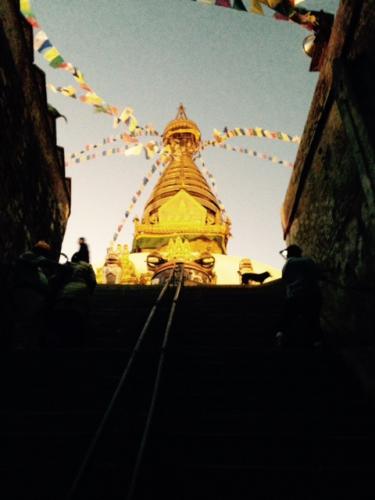
Stupa at the monkey temple
We stood still while the chase went on by. Looking down there would often be one walking within 2 feet of me! A baby monkey’s cry is rather like a kitten … very strange.
And then someone came to feed them, spreading grain onto the walkways, where easily a hundred or more monkeys waited.
 Monkeys at the temple
Monkeys at the temple
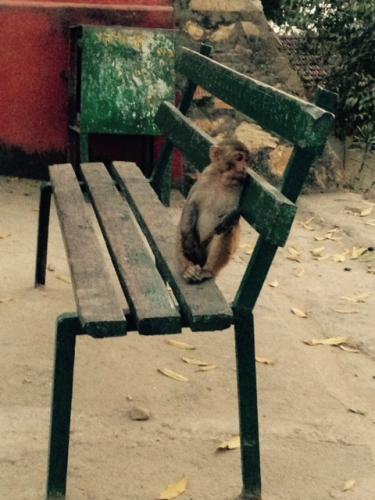
The streets are not named in Kathmandu. Only the main streets or “marg” or the major intersection or “chowk” (pronounced chalk); the rest are known for the district or major temple in the district. So I am staying in Baluwatar, or at Mayur Guest House, near Baluwatar chowk; about 1 kilometer up the road from the Bhat Bhateni chowk (Bhat Bhateni is a department store. But be careful! There are 5 of these chain stores in Kathmandu). I work in New Baneshwor (a friend works in Old Baneshwor). At my office, the staff and I had to identify our building location on the map by finding the large vegetable wholesale market next door, as none of the little streets are named.
I’ve learned to make sure I know of a store or a recognizable feature to look for as a drop off point when getting out of a cab, such as the Big Mart Store in Lazimpat, which is much more commonly known than the very amazing Jazz Upstairs pub. The locals don’t always know the name of the restaurant or store you are trying to find, so be prepared to walk a while, and phone the other volunteers for directions or to come and find you!
Fruit venders hang their wares outside their stores, so small bunches of bananas are strung up and hang as if on a fruit tree, or pineapples are attached to hooks on the walls outside. I won't post a pic of the butcher shop and what he displays!
The propane tank delivery guys scare me. They ride on bicycles, with 30 lb propane tanks hanging on each side of their rear tire, like saddle bags. Often one more is strapped sideways behind their seat, similar to how we would mount them on a forklift. And they ride along with tanks hanging right out in traffic.
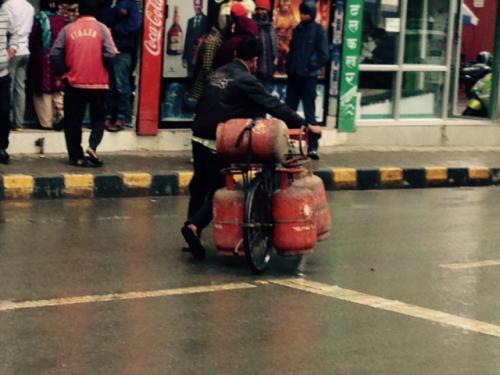 Propane Delivery
Propane Delivery
Of course, traffic here is scary anyway. Only the people in the front seat of a car wear seat belts (they don't work in most cabs anyway) and only the driver on a motorbike wears a helmet ... not the 1, 2 or even 3 passengers! Everyone edges in to where they want to go, fairly slowly but insistently and for that reason, amazingly, there seem to be few actual accidents. Maybe there are lessons to learn?
I've spent the day working on reports, as I'm sure this final week will fly by! Training sessions and meetings, a couple of dinners out planned and even a shopping trip with the office girls to another Bhat Bhateni, near Kopundol this time. Friday night and time to leave this amazing place comes all too soon!
Challenges
I’ve shared a number of my awesome experiences here, so let me share some challenges:
Load shed: it’s taking 2 full minutes (or more) to attach a picture to an email. At my office, which has no back-up generator, we work sometimes 5 – 6 hours (Monday and Tuesday are worst for my office) with no electricity and no internet (and of course, no heat in the building – though they do have propane tank heaters for inside!!). Oops! I’ve just set off the alarm by plugging in the kettle during load shed; no tea tonight but at least I have lights and internet!
Water: water is not always taken with meals; super sweet “black” tea or creamy buffalo milk tea is often enjoyed earlier or after. Sometimes lack of water is related to load shed and buckets of water are provided to “flush”. Since drinking water is not often ad lib or safe from the tap, I wonder if that (and the lack of availability, along with the logistics involved in carrying it) is sometimes the reason that it is not offered ad lib to the animals (think how that affects dairy milk production!). What an appreciation I will have for our abundance after my time here.
Dust: street dust is everywhere, which is why shoes are usually removed when entering the offices. So you are wise to bring slippers … see the point about lack of heat above! Cattle wander the streets on occasion, even young bulls. Not sure what they eat in the city. Most goats I see are tied up - outside the butcher shop!
Air quality: see dust, above. Now think cars and trucks, scooters and motor bikes, many are diesel, pretty sure there is no emissions testing, lined up, honking, squeezing past each other in a city of roughly 2 million. I have seen 4 intersections with street lights – none of them working. Police stand in the street and direct traffic. I have seen a couple of police horses, standing quietly “ground tied” with their reins looped over their withers in the middle of 6 lanes of honking mayhem! People buy cloth masks and wear them often, or hold scarves over their nose and mouth; I brought a 3M N95 respirator and I’m sure I look like I’m from Mars!
Dogs: the street dogs are everywhere; they sleep all day, often in the middle of the road (traffic goes around them on small streets) or curled up into doorways. They often bark all through the night, going about their business of maintaining their territory. They are dusty and full of bite marks. It breaks my heart to see puppies and not be able to rescue them- I miss my own dogs! People walk around them and ignore them, and they ignore people mostly. They do respond to honking cars, walking carefully along curbs and crossing safely. There are some pets here too. I’ve seen german shepherds, a boxer pup and a chihuahua at the pet store and of course, the famous pug breeder near the Passage house, where most Leave for Change volunteers stay. Feeding time is 5 am!! Oh, and streets can be messy with dog mess added to the dust.
People: the people here are amazing! Dressed in brightly coloured clothing, from an array of fashions. Ladies in silky and satiny saris under winter coats drive scooters while wearing high heeled sandals or sit sideways behind as a rider; others wear traditional long tunics over pants, and some are in modern day wear. Many are still wearing sandals at this time of year, and then barefoot indoors! It’s perfectly safe to walk alone at night here. I was lost earlier tonight in the dark after getting out of a cab a few streets early. No one bothers you. They will try to help when approached, though we don’t always understand each other. When Nepalis meet you, they invariably ask where you are from, why you are here in Nepal, and what you think of the country. They are curious, kind and sharing, make and eat amazing foods. I’m so lucky to be here and hope I'm able to make a difference.
Work and Play
Last weekend, I took a holiday of 2 days with some other girls here from Ottawa and UBC and we flew to Pokhara on Saturday morning, about a 35 minute flight. We boated across Lake Phew, past an island with a temple and climbed a mountain (the book says its a peaceful stroll -- HA!! it was a good uphill climb for an hour!) up to the Peace Tower stupa; my legs were relieved to reach the top (and wobbly by the time we returned to the bottom!).
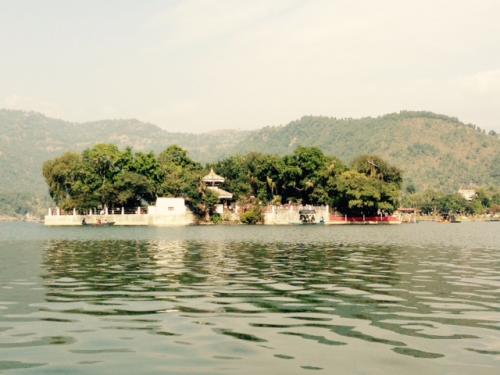 Temple we saw from the boat
Temple we saw from the boat
 The "peaceful stroll" up the mountain
The "peaceful stroll" up the mountain
The climb was well worth it; a peaceful and beautiful site of white stupa, with 4 different poses of Buddha. You can see a devotee in traditional garb seated on the steps. There is a request for silence on the grounds, and the area is lined with prayer flags blowing in the wind. You can certainly find peace in a place like this! So much history everywhere in this land...many details are captured on my camera not my phone, so will revisit the historical information later.
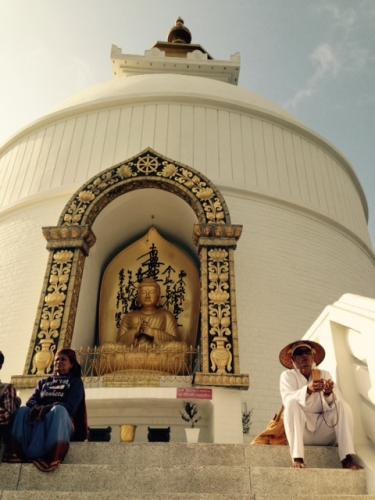 Peace Tower Stupa
Peace Tower Stupa
Back in the tourist community of Pokhara Sunday morning we went para-sailing!!! I put it down to peer pressure (teasing my younger trip mates), but I jumped off the mountain and it was amazing. I'd even do it again!
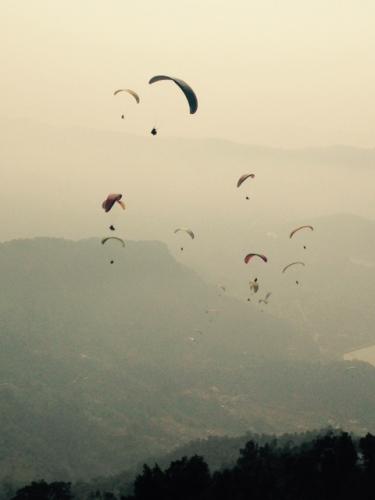 Para-sailing
Para-sailing
Our respite was quick and we returned Sunday afternoon back to the big city rush and noise and traffic, and a renewed focus on our mandates.
Last night the staff here at the Mayur guest house had a bbq and singsong out on the patio, and invited us to join in. A lovely group of people, this is a such a safe and friendly country! Everyone asks where you are from...why you are here, how long you will stay and what you think of Nepal. It's easy to give glowing responses!
 Singing on the patio
Singing on the patio
Day time weather is still around 18 degrees in the sun but inside the buildings it feels more like 15, so you dress in layers and work in your coats. I haven't needed gloves in the office yet, as I share a desk with my counterpart and he has the sunny corner of the building. We also share an internet cable and as mentioned, with load share, power can be limited. Monday and Tuesday there is no power in the office most of the day (10 am – 3 pm) so it's best to arrive with the laptop charged and prepare to switch to a notebook! At night I think it's still about 8 degrees out, at least according to the Weather Network. Frankly, it's warmer outside than in, at night and early morning.
I’m getting busy with work now with 2 workshops and 2 board meetings in the next week, handouts developed and being translated, PowerPoints printed. (One training is during load shed, so there will be no projector. Showing the PowerPoint on my laptop with paper copies will suffice.)
I had some time to bond with the ladies in the office here, Sarala and Bhawani. Nepalis love to have their pictures taken and we snapped some selfies. I was also given a tika, as a married lady, though I'm not sure if the size of the dot is related to caste.
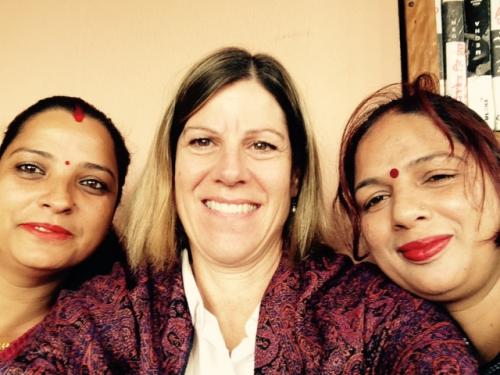 Selfie with Sarala and Bhawani
Selfie with Sarala and Bhawani
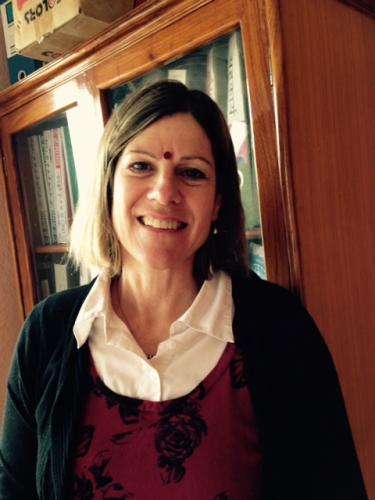 My tika
My tika
Some of the stores are decorating for Christmas here. A large tree just popped up outside the Bhat Bhateni, the department store down the street. Most of the population of course are Buddhist or Hindu, and there are either religious based or caste based festivals almost every weekend.
One amazing reminder of Christmas at home is that poinsettias grow wild here. I've counted about 6 varieties, and they are often 15 feet tall bushes! Some are double flowered, some more like a pom pom. Only 1 yellow (white) variety has been spotted, cultivated at the guest house we stayed at in Pokhara. Pretty cool!
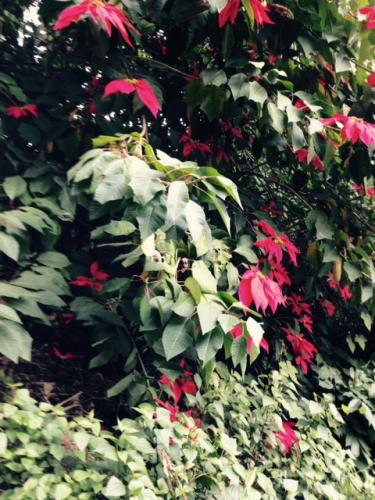 Poinsettia bush
Poinsettia bush
Working girl
Working in offices here can be challenging, when load shedding (power outs) rotate daily and there is no back-up generator. Wireless internet is not everywhere, and in my office at CDCAN we share an internet cord.
That said, much progress has been made! I will make presentations at two Board meetings over the next two weeks, as well as deliver an in house workshop on grant proposal writing. In addition, I will co-present a workshop on grant proposal writing tips to the CECI staff and partners. Much material to build and get translated!
This week my office counterpart, Kabiraj Humagain and I travelled to visit two dairy milk collection centers and met with the local District Milk Producers Cooperative Union (DMPCU) executives. The comparative analysis resulting from these site visits, one to an advanced Collection Center, and the other to a collection center that has greater geographical and infrastructure challenges, I will be able to better understand and assist with the fund proposals needed for the dairy industry here.
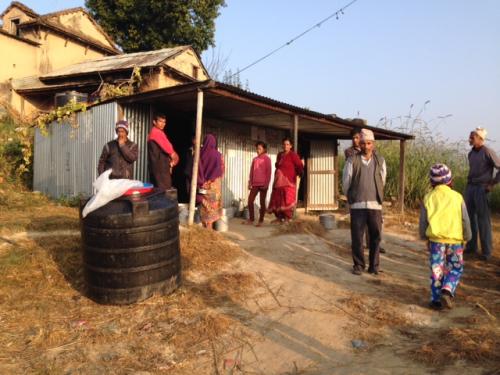
Travel is not easy over distances of 20 – 30 km into the hills, but the vistas – wow! Amazing! Here are some photos that I hope will show the terraces of farming.
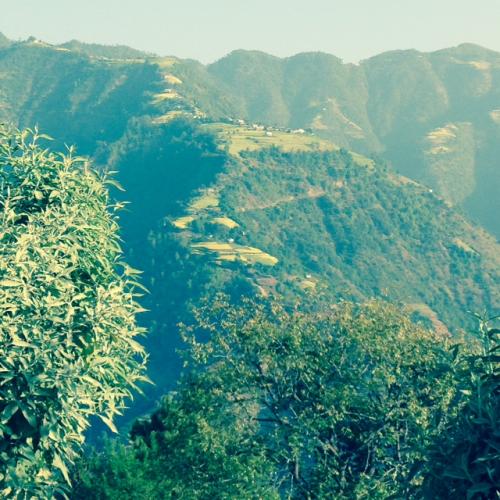 Road to Bagdevi
Road to Bagdevi
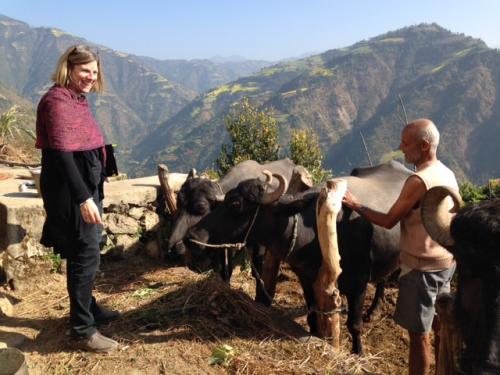
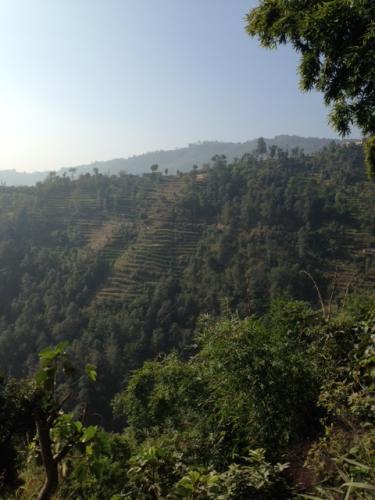
I was also formally welcomed to the CDCAN office by the Chair of our Board, Mr. Narayn Parasad Devkota, with a welcome ceremony – given a welcome scarf and “tika”, the red forehead powder, worn by many for good luck.
Today, Friday December 5, is International Volunteer Day, and our group is meeting at the Hotel Himalaya, Kupondole with other volunteer programs, from Australia, Japan, Korea, the UN, and the Peace Corps, to make presentations about our volunteerism experience and what our roles are in Nepal.
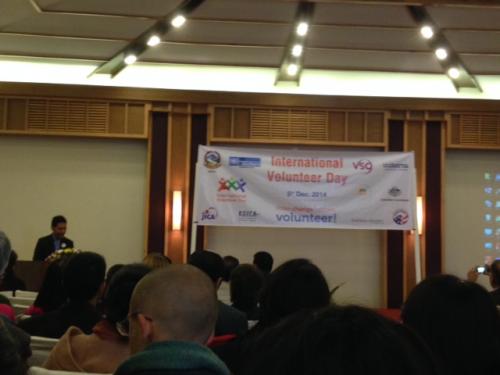
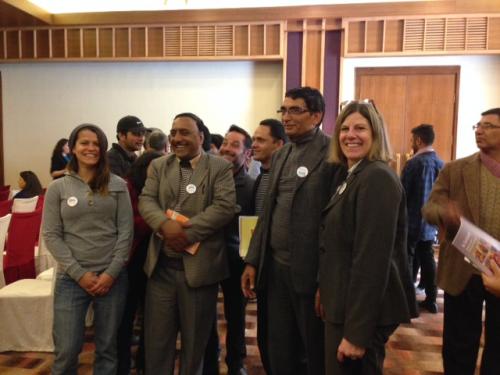
This evening is an additional presentation and reception, hosted by CECI here. Tonight will be a quiz show activity – wish me luck!
Building upon foundations
What a week!
I worked in the CECI office a couple of days on my “surprise” additional training session and again today, Sunday. Fortunately, another long term volunteer is helping me with that training. In building the session tools, I’m actually getting a jump start on materials that will be useful for my mandate with the Central Dairy Cooperative Association of Nepal.
Friday was busy with meeting my partner organizations: first we travelled across town to meet the leadership of the Central Dairy Cooperative Association of Nepal (CDCAN), the national umbrella association for dairy farming where I will spend most of my time. Then we returned to the CECI office area for my welcome lunch (which I missed, however there was still some food, at Maple once again; I remembered the "note to self" - do not eat the hot relish!).
In the afternoon we travelled further afield to Lalitpur to meet the leaders of the Lalitpur District Milk Producers Cooperative Union, which is supported by the group I met in the morning. It is the oddest thing to meet with people when you have removed your shoes to enter the offices, but everyone keeps their winter coats on, as it's colder inside than outside!
These associations have a long list of requests for assistance, but together, the CECI Program Coordinator, Sagun, and I narrowed my mandate down to several items, including 2 training sessions; one for those at the CDCAN office level and another to include appropriate staff from both associations and appropriate NGO members. I will likely also be meeting with government officials, to "test the waters" for seed funding.
I should note that a number of the U of G personnel who have volunteered in Nepal have been involved with the Dairy programs here. I’m so fortunate to have input and access to past reports from Mary, Mandy and Looknauth, which have provided me not only supportive materials to build upon for my mandate, but also many details, names and suggestions so that, upon arriving I felt like I already knew many of the staff and volunteers working here.
Meanwhile, Saturday was a tour of the city. We began with visiting the Boudhanath stupa at Boudha. We also toured the Hindu temples at Pashupatinath and finally temples at Patan Square – where there was a World Peace rally going on. The buildings, statues, temples and stupas are amazing!! At Boudha, the peacefulness was palpable as devotees walked around the stupa, clockwise, many slowing to spin the prayer wheels. Prayer flags flap in the breeze – they must be hung outside, so that the prayers and blessings can be blown to others and peace spread on the wind.
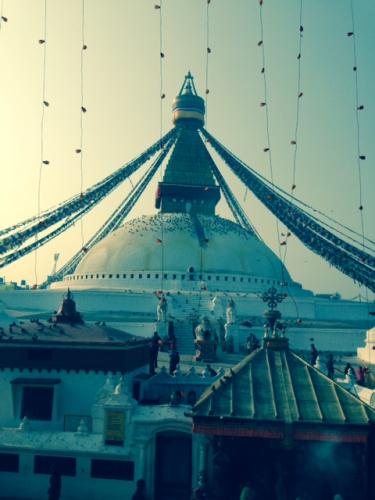 Boudha
Boudha
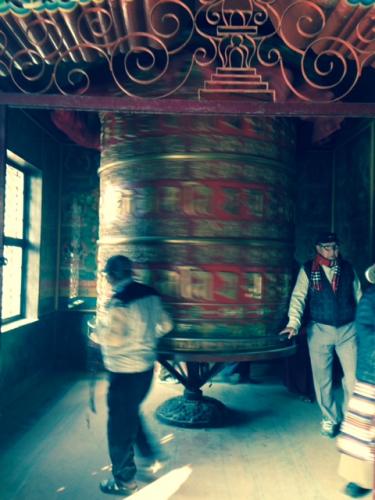 Spinning the prayer wheels at Budha
Spinning the prayer wheels at Budha
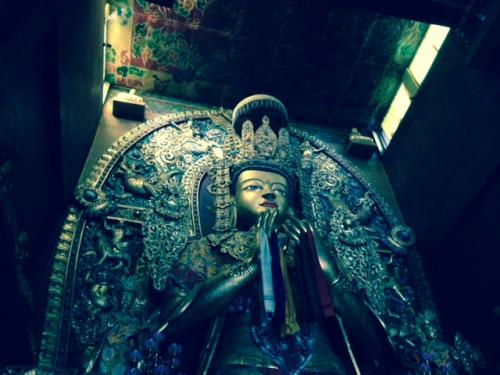 Buddha statue in temple at Boudha
Buddha statue in temple at Boudha
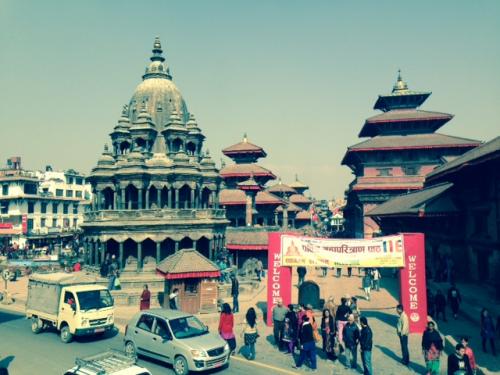 World Peace Rally at Patan Square
World Peace Rally at Patan Square
At the Hindu temple, animals are often set free and non-Hindus may not enter. There were monkeys, goats and bulls…freely walking about, eating grain put out for them. A young jersey type bull (with horns) walked right behind me, while others lazed in the sun.
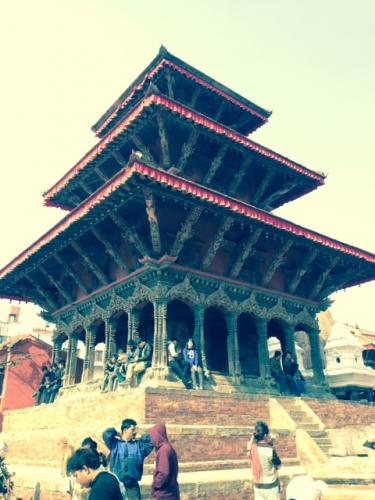 Hindu Temple in Pashupatinath
Hindu Temple in Pashupatinath
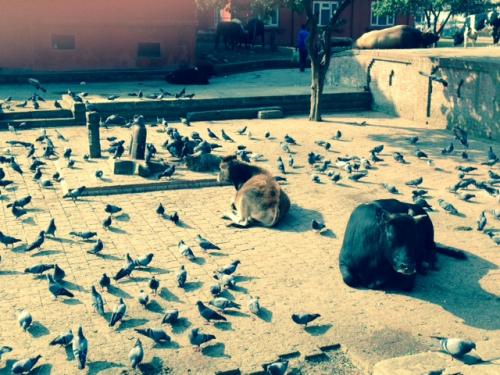 Bulls at the temple
Bulls at the temple
Our tour also took us to the burial crematorium at the river. What a humbling sight, to bear witness to the end of life and the acceptance of the circle of life here. And adjacent to the area, are the ever present souvenir tables selling statues made of stone, clay and brass, and jewellery.
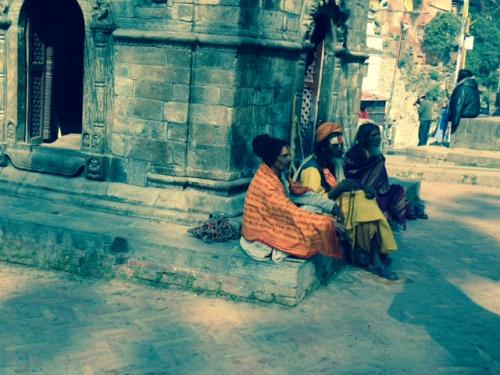 Holy men, near the crematorium
Holy men, near the crematorium
Next we were headed to the Fair Trade Christmas Bazaar - some of the volunteers are assisting with the Fair Trade Group or other partner associations, such as the Women's Entrepreneur Association of Nepal, where Dana, a volunteer from UBC is posted. It was crowded with shoppers and supportive followers.
Leaving there, it should be noted: everywhere you go, car, truck and motorbike horns beep incessantly to warn pedestrians and drivers alike; pedestrians walk on sidewalks, roads and in the gutter. Some locations are so crowded it's a miracle that no one is injured in traffic.
Exotic places
Flying into Doha, Qatar, I was amazed to see the landscape – light brown sand as far as the eye can see, dotted with sometimes barely discernable light brown buildings. Transferring at the airport was straightforward to the final plane, though I wished I had time to shop – or at least gaze upon the designer name products and fare available in the boutiques. There is the most interesting statue in the airport – a huge teddy bear, complete with button eyes - which is rather surprising at 23 feet tall and weighing in at 35,000 pounds! Reported to have been bought for $6.8 million by a member of Qatar’s royal family, this bear was previously displayed in front of the Seagram Building on New York’s Park Avenue and auctioned off at Christie’s New York.
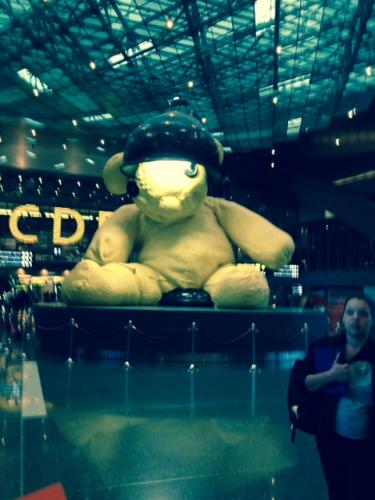
During the next leg, from Doha to Kathmandu, I was seated with an older lady, Tara, who had lived in the US for years, but now has retired back in Kathmandu. Her 3 kids, one with a grand kiddie, were all in the States, where she had been visiting. We got to chatting about the CECI program and Leave for Change and it turns out that the CECI office was in her neighbourhood. In fact, if I was in the area of Mike’s Breakfast (a well-known restaurant) I could ask for her, as she was in there all the time. We exchanged emails and went on our way.
Visible from the plane was a landscape that first resembled dry brown lowland with an occasional wandering road. Later the land appeared as a giant sandbox, with ridges and dunes, some steep cliffs, shaped roughly in large square or rectangular patterns as if by children at a beach. Closer to Kathmandu, a line of snow-capped mountains was visible past clouds on the horizon – majestic and remote, the snowy peaks presented a chilling reminder of winter for this Canadian! Below the mountainous area were wide dry river beds, tangled paths that the water must follow during monsoon season. I said I was not going climbing, but I may take a flight to Pokara, which is the “Lake Louise” of Nepal, and the flight promises great views of the mountains too.

Escaping from the plane into the Kathmandu airport, my traveling partner, Aisha from the Association of Universities and Colleges of Canada, and I found the lines for Tourist Visas short, though the lines for free Visas (except Indian) was where most travelers went and extended quite long; still though nothing in comparison to the lineups at Pearson when returning from international vacations...so maybe we were just lucky!
Outside the airport, the street area was lined with drivers with names on signs meeting the arrivals. It was hard to know if there were more crowds than usual, though security screening was tight; it seems that the South Asian Association for Regional Cooperation (SAARC) Summit is occurring here and many Asian country leaders were arriving also. In fact, the government issued an order to reduce traffic in the area prior to the Summit: cars with odd license plates could drive on odd days, and even numbered plates on even days!
In addition, the days of the actual Summit (Wednesday and Thursday November 26 and 27) have been declared national holidays! The theme for the 18th SAARC Summit is "Deeper Integration for Peace and Prosperity". Attendees include presidents or prime ministers from Afghanistan, Bangladesh, Bhutan, India, Maldives, Pakistan, Sri Lanka and of course, Nepal. While I didn’t see any of them, the arrival of these heads of state has affected my visit, as the Central Dairy Cooperative Association of Nepal (CDCAN) office where I will be working, is closed until Friday and so my meeting with the partner association and CECI program officer has been delayed until then. Never mind, as I was given an idea of their needs to start working with. Oh, and as a special surprise project, I’ve been given the opportunity to deliver a training session on proposal writing to all the volunteers working at the CECI offices, also!
Back to my meeting with Tara on the flight over – as our car arrived at Mayur House, a motel where we will be staying, Tara’s arrived at the same time. She and her husband, a doctor, live next door! In a city with a population in the millions, what chance is that - it is truly a small world! In true Nepali hospitality I’ve been invited to brunch in the adjoining courtyard, on Sunday if I’m not working, where eggs and tea are complementary and everyone brings something.
Traffic here includes a flurry of scooters, cars and vans which hurtle down roads, treating the central lines as mere guidelines, and moving amongst each other in a madly unchoreographed dance. Pedestrians, dogs and sometimes cattle, walk in the road often, stepping up the super high curbs (designed to handle the onslaught of monsoon weather in summer) when the tooting of horns announces oncoming vehicles…which is continual! The streets are lined with shops, dusty and crowded with funny 3 wheeled vehicles called tuk tuks, scooters and cars; local buses get packed to a point that is well beyond the comfort of personal space that we Canadians may be used to! Dogs are standing or curled up asleep all over the place, some with evidence of past litters, all are rough looking mixes, and not a one I can pet! I’m told that many street dogs were culled in the past so there are fewer than there were.

The first day of orientation was very welcoming: we were toured through the offices and introduced to several Canadian volunteers – all longer term (5-8 months) and some University interns here for a school year; we reviewed general information and were treated to a welcome lunch for 3 newly arrived volunteers from Australia at a local eatery – the Maple restaurant, which served up delicious curry dishes, potato paneer, fried chicken and some cabbage kimchi garnish (which, it turns out, was not best consumed on its own, as a mouthful!)
Today was another day of orientation – a history lesson on the political atmosphere in Nepal, and a discussion on possible "bandhs" or strikes. Travel plans are simply adjusted if road blockages occur, and life in Nepal – at least in Kathmandu – continues.
Leaving winter behind...
While the weather outside in Southwestern Ontario is frightful, I'm packing and repacking for the different weather that is winter in Nepal, including hot water bottles, multiple layers of clothing and fingerless gloves for office work!
The adventure starts early this Sunday November 23, with travels through Philadelphia, and Doha, Qatar to Kathmandu, exotic names and places, mostly!
I've been fortunate in having a lot of support from a number of past volunteers, and even been in contact with a few who are still there. Hopefully I will be able to pick up and add to the work done by many others.
News - heading to Nepal!
I've just learned that I will be travelling to Nepal sometime this November and assisting as a Proposal Writing and Training Advisor for the Dairy Cooperatives there! I will be with working with the Lalitpur, the Makawanpur and the Rupandehi District Milk Producers’ Cooperative Union (DMPCU), all members of Central Dairy Cooperative Association Nepal (CDCAN), which were formed to assist the primary dairy cooperatives to better deliver services to their members and through them serves thousands of households. Apart from milk transactions, the Central Dairy Cooperative Association Nepal provides related value added services to its members in production, marketing and policy advocacy. My role will be to work with all the 3 three DMPCUs, to assist in enhancing their skills in writing proposals so that they are able to secure funds for their on-going as well as future projects. I will be based in Lalitpur, Nepal, about 1 hour from Kathmandu!


